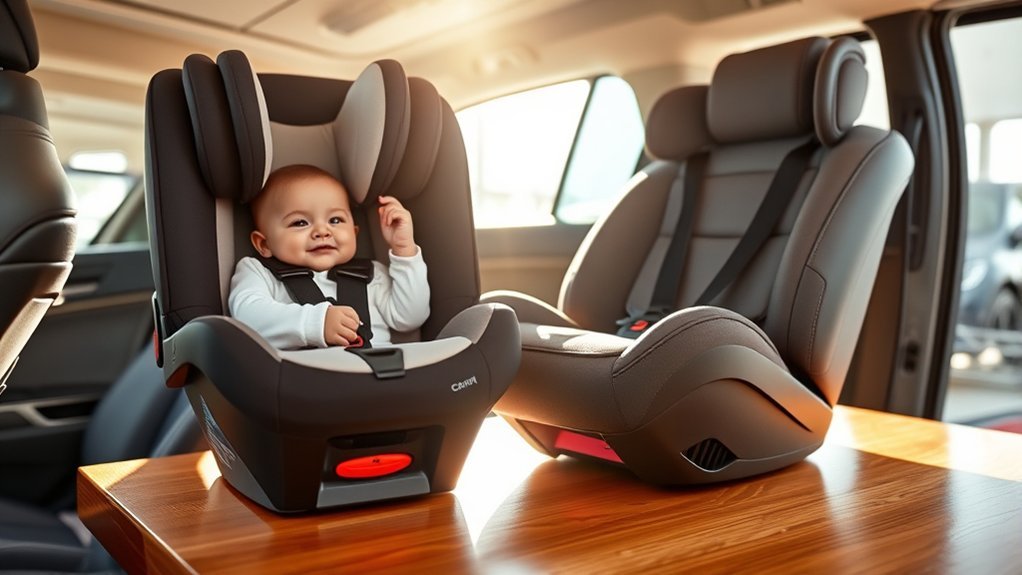When choosing between infant and convertible car seats, safety, convenience, and longevity matter. Each type offers unique features tailored to specific age and weight requirements, yet many parents mistakenly shift to convertible seats too soon. This premature switch can increase crash risks. Understanding common misconceptions and the correct usage of these seats is essential. What factors contribute to these misjudgments, and how can you guarantee your child’s safety?
Understanding Infant Car Seats: Features and Safety
When you choose an infant car seat, understanding its features and safety standards is essential for your child’s well-being.
Look for seats that comply with Federal Motor Vehicle Safety Standards (FMVSS 213), guaranteeing they meet rigorous safety requirements. Check for a five-point harness system, which evenly distributes force across your child’s body during a crash.
Additionally, consider features like side-impact protection and energy-absorbing foam, which enhance safety. A removable, washable cover is practical for maintaining hygiene.
Confirm the seat fits securely in your vehicle, and always follow the manufacturer’s installation guidelines. Finally, verify the expiration date, as materials may degrade over time, compromising safety.
Prioritizing these elements will help you make an informed decision for your infant’s safety.
Exploring Convertible Car Seats: Versatility and Protection
Convertible car seats offer remarkable versatility and long-term value for parents seeking ideal protection for their growing children. These seats can shift from rear-facing to forward-facing, accommodating various stages of your child’s development. This dual functionality means you won’t need to purchase multiple seats, saving you both money and time.
Designed with safety in mind, convertible seats often feature advanced harness systems and side-impact protection, ensuring your child remains secure during travel. Many models also allow for adjustable recline positions, enhancing comfort for your little one.
When properly installed, convertible car seats provide a reliable solution that adapts to your child’s size and needs, giving you peace of mind as they grow. Prioritize safety and convenience with this essential car seat choice.
Age and Weight Recommendations for Each Type
Understanding the age and weight recommendations for infant and convertible car seats is essential for guaranteeing your child’s safety on the road.
Infant car seats generally accommodate newborns up to 30-35 pounds and up to 32 inches in height. These seats are designed for rear-facing use, providing ideal head and neck support for infants.
Once your child exceeds the infant seat’s weight or height limits, or reaches around 2 years of age, shifting to a convertible seat is recommended.
Convertible seats can be used rear-facing for children weighing up to 40-50 pounds, and forward-facing for those up to 65 pounds or more, depending on the model. Always check the manufacturer’s specifications to confirm compliance and safety.
Common Misconceptions About Car Seat Safety
Many parents hold misconceptions about car seat safety that can jeopardize their child’s well-being.
One common myth is that it’s safe to switch from an infant seat to a convertible seat as soon as your child reaches the minimum weight requirement. However, children should remain in rear-facing seats until they exceed the maximum weight or height limit specified by the manufacturer.
Another misconception is that a car seat’s expiration date is irrelevant. In reality, materials degrade over time, compromising safety.
Additionally, some believe that using a second-hand car seat is acceptable; however, without knowing its history, you can’t guarantee it’s free from damage or recalls.
Understanding these misconceptions is essential for making informed decisions about your child’s safety in the vehicle.
Evaluating the Risks of Using Incorrect Car Seats
While it might seem convenient to use an incorrect car seat, the risks involved can have serious consequences for your child’s safety. Incorrect car seats, whether they’re too large, too small, or improperly installed, can lead to inadequate protection during a crash.
For instance, an infant seat used for a toddler mightn’t secure them properly, increasing the likelihood of injury. Additionally, using a convertible seat too soon can expose your child to risks if it’s not designed for their weight and height.
Always check manufacturer guidelines and verify the seat fits your child’s current size. Regularly inspect your installation and make adjustments as your child grows, guaranteeing ideal safety and compliance with regulations.
Frequently Asked Questions
Can I Use a Convertible Seat for Newborns?
Yes, you can use a convertible seat for newborns, but guarantee it’s rear-facing and meets safety standards. Always check the manufacturer’s guidelines for weight and height limits to guarantee proper fit and safety.
How Do I Install a Car Seat Correctly?
To install a car seat correctly, read the manufacturer’s instructions, verify the seat’s base is level, use the vehicle’s seat belts or LATCH system, and check for tightness by pulling at the base.
What Are the Best Brands for Safety Ratings?
Like a fortress protecting your child, brands such as Britax, Graco, and Chicco consistently earn top safety ratings. They combine innovative design with rigorous testing, ensuring your little one’s safety during every journey.
Are There Expiration Dates for Car Seats?
Yes, car seats do have expiration dates, typically ranging from six to ten years. Check the manufacturer’s label for specific dates, as using an expired seat can compromise safety during a collision.
How Can I Determine if My Child Has Outgrown Their Car Seat?
You can determine if your child’s outgrown their car seat by checking their height and weight against the manufacturer’s limits, ensuring their shoulders are below the harness slots, and confirming their head is at least an inch below the top.
Conclusion
Choosing the right car seat is essential for your child’s safety. As the saying goes, “An ounce of prevention is worth a pound of cure.” By understanding the features of infant and convertible car seats, and adhering to age and weight recommendations, you can greatly reduce the risk of injury in the event of a crash. Don’t let misconceptions guide your decision; prioritize proper installation and usage for the best protection on the road. Your child’s safety depends on it.
